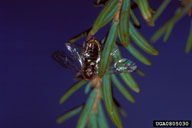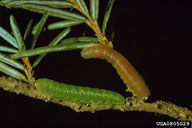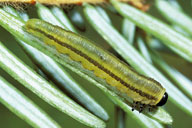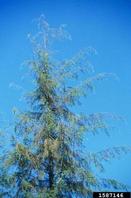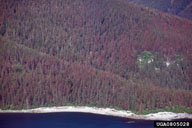Hemlock sawfly
Neodiprion tsugae Middleton (Hymenoptera: Diprionidae)
Orientation to pest
The hemlock sawfly, Neodiprion tsugae Middleton, is an important native defoliator of western hemlock (Tsuga heterophylla [Raf.] Sarg.) in western North America. This sawfly overwinters as eggs, which are laid in the fall in needles of the current year's growth, usually one egg per needle. Eggs hatch in spring and the larvae feed into early summer. Young larvae usually feed gregariously, but change to feeding singly as they mature. The larvae eat the old needles, reducing growth but rarely killing trees. Mature larvae drop to the duff where they spin cocoons. Usually there is one generation a year, but some larvae take more than one year to complete their life cycle. Extensive outbreaks on western hemlock have been recorded in natural forests in Oregon, British Columbia, and Alaska, often in association with outbreaks of blackheaded budworm (Acleris gloverana Walsingham). In coastal Alaska, defoliation can be concentrated on large trees on southern and western slopes near waterways. In British Columbia when hemlock sawfly is associated with blackheaded budworm, thinned stands have been reported to suffer heavier defoliation than unthinned stands.
Hosts commonly attacked
The main host is western hemlock (Tsuga heterophylla [Raf.] Sarg.), but in addition, mountain hemlock (Tsuga mertensiana [Bong.] Carr). and Pacific silver fir (Abies amabilis Douglas ex J.Forbes) are sometimes attacked as well.
Distribution
This sawfly is found in coastal forests of western North America in Oregon, Washington, British Columbia, and Alaska. It also occurs in interior forests of British Columbia, Idaho, and Montana.
 USDA Forest Service • Forest Insect and Disease Leaflet 31 USDA Forest Service • Forest Insect and Disease Leaflet 31 |
| Figure 1. North American distribution of hemlock sawfly |
Images of hemlock sawfly
| Figure 2. Adult of hemlock sawfly, Neodiprion tsugae | Figure 3. Larvae of hemlock sawfly | |
| Figure 4. Cocoon of hemlock sawfly from which the adult has emerged | Figure 5. Feeding damage (thin foliage) of hemlock sawfly on western hemlock | Figure 6. Stand of hemlock showing extensive damage during outbreak of hemlock sawfly |
Important biological control agents related to this pest species
Parasitoids attacking hemlock sawfly include the ichneumonids Delomerista japonica diprionis Cushman, Oresbius tsugae tsugae (Cushman), and Itoplectis quadricingulatus (Provancher). ). A fungus (Entomopthora sphaerosperma Fres.) was the most effective control observed in studies in Alaska, particularly in wet years.
Web links for information on hemlock sawfly
Articles
- Furniss, R. L. and P. B. Dowden. 1941. Western hemlock sawfly, Neodiprion tsugae Middleton, and its parasites in Oregon. Journal of Economic Entomology 34: 46-52.
- Hard, J. S. 1976. Natural control of hemlock sawfly, Neodiprion tsugae Middleton (Hymenoptera: Diprionidae), populations in southeast Alaska. The Canadian Entomologist 108: 485-498.
- Hard, J. S. and D. C. Schmiege. 1968. The hemlock sawfly in southeast Alaska. USDA Forest Service Research Paper No. PNW-65, 11 p. Pacific Northwest Forestry and Range Exp. Station, Portland, Oregon
- Torgersen, T. R. 1968. Parasites of the hemlock sawfly, Neodiprion tsugae, in coastal Alaska. Annals of the Entomological Society of America 61 (5): 1155-1158.
